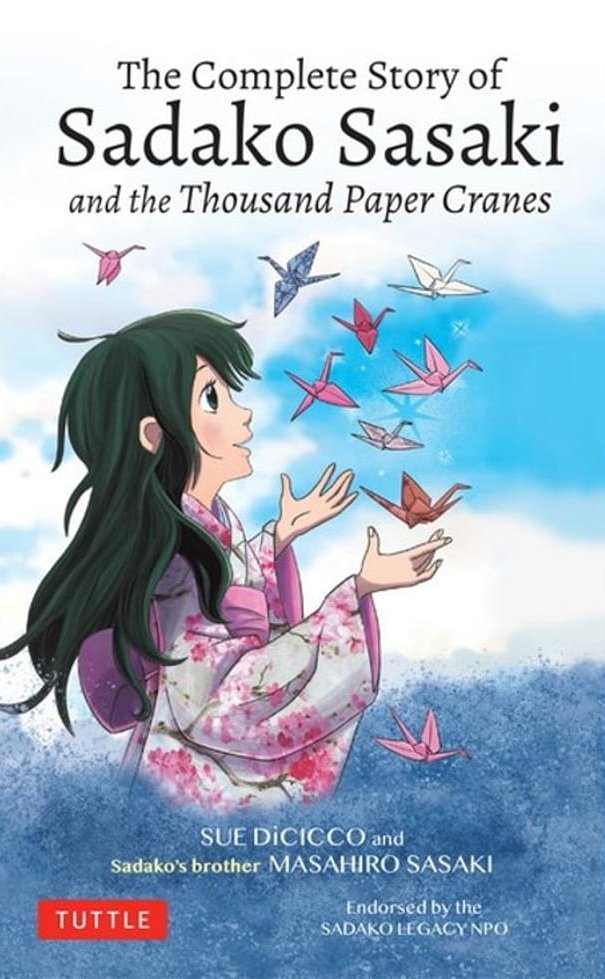The Complete Story of Sadako Sasaki and the Thousand Paper Cranes by Sue DiCicco and Masahiro Sasaki (Tuttle)
There are many books about the story of the thousand paper cranes which were first created to commemorate the children who lost their lives during the atomic bombing of Hiroshima and for those who suffered afterwards, even many years later, from their exposure to radiation. They have become an international symbol of peace.
Sadako Sasaki was a twelve-year-old girl whose story has often been repeated in a number of publications. However, author Sue DiCicco says in the preface of this 2020 publication, “So much of what I’ve read about Sadako was contradictory and felt incomplete.” The author wanted more details about her life story, what she went through, and how her family remembers her.
DiCicco’s curiosity led her to contact Sadako’s brother Maashiro Sasaki. Together, they collaborated on bringing new light to Sadako’s story as seen through the eyes of someone who was there with his little sister when the atomic bomb dropped. Now Tuttle has published The Complete Story of Sadako Sasaki and the Thousand Paper Cranes.
Sadako Sasaki was born on January 7, 1943. Her father Shigeo owned and ran a barbershop. Her mother, Fujiko, gave birth to her in a neighbor’s rickshaw when he was doing his best to take her to the hospital at four in the morning. They named her Sadako whose kanji character, 禎 means “happiness”.
On the morning of August 6, 1945 an air raid alarm sounded and all the citizens of the city hurried to go to one of the shelters and listen for the “all clear” signal. The plane had only passed over the city and the “all clear” was sounded.
As the family was about to eat breakfast, they heard people yelling outside. They also went to investigate. The grandmother was not interested in the airplane and called them back to the table. Just as they sat down at the table, “the city lit up with what seemed like the brightness of a thousand suns, followed immediately by an enormous explosion”.
The unthinkable had happened. For the first time in history, an atomic bomb was dropped on a populated area of a city, killing an estimated 80,000 people instantly. Sadako Sasaki was only two years old.
It would be almost ten years later when the affects of the atomic bomb manifested in Sadako. Although her parents did not want to believe it, Sadako was diagnosed with leukemia. It was 1955 and back then leukemia was incurable.
One day Sadako received a long string of colorful cranes folded for the patients by the Red Cross Youth Club at Aichi Shukutoku High School. Sadako didn’t yet know the significance of its meaning. Her father explained that “giving paper cranes to someone in the hospital means that you hope they’ll get well soon”.
He also told her the legend of the crane. It is said that it can live for one thousand years. “An ancient Japanese legend promises that anyone who folds one thousand cranes, one for each year of a crane’s life, will be granted a wish. This story made cranes a favorite gift for anyone experiencing a life event, especially someone getting married or suffering from an illness.”
The story inspired Sadako to reach the goal of folding one thousand paper cranes herself. She wanted her wish to come true. She “wanted to be well, to return to school, and to live with her family again”.
Sadako accomplished her goal but she didn’t get any better. Instead of feeling bitter or sorry for herself, she thought she would just fold another one thousand. Sadako Sasaki died on October 25, 1955 at the tender age of twelve.
Her death inspired her friends and schoolmates to build a monument in memory of her and of all the children who died from the effects of the atomic bomb. They raised enough money and on May 5, 1958 it was unveiled. It is located in the Memorial Peace Park in Hiroshima, Japan. It has the title of 原爆の子の像 (Genbaku no Ko no Zo) which directly translates to “Atomic Bomb Children Statue”. The title of the monument in English is the “Children’s Peace Monument.”
Sadako’s story is a story of inspiration and courage. It is also a testament to the horrors of war. The story of her life carries an important message, one that we should take heed of, to strive for peace and to work together to accomplish that goal. ~Ernie Hoyt
